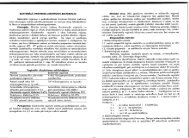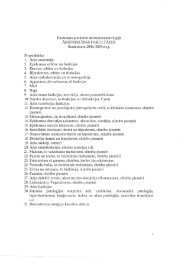PHYSICS
n - susliks.lv
n - susliks.lv
- No tags were found...
Create successful ePaper yourself
Turn your PDF publications into a flip-book with our unique Google optimized e-Paper software.
Sensory nerve<br />
to eNS<br />
Intrafusal muscle fiber<br />
(muscle spindle)<br />
------.... , I _Tendom<br />
j<br />
Extrafusal muscle fiber<br />
Goldi tendom<br />
organ capsule<br />
Tendon inserts<br />
into bone<br />
Fig. 5.5. Muscle spindle which is in parallel<br />
with the extrafusal muscle fibers<br />
Fig. 5.6. The Goldgi tendom organ <br />
a stretch receptor located in the<br />
tendom of skeletal muscle<br />
Tendom<br />
spindle sensory (afferent)<br />
nerve as action potentials to<br />
the brain. The frequency of<br />
the potentials depends on<br />
lengthening of the middle<br />
part of the skeletal muscle.<br />
The Golgi tendom organ<br />
is presented as a slender<br />
capsule within the tendom.<br />
It is connected with 15 <br />
20 skeletal muscle fibers<br />
(fig. 5.6) and supplies information<br />
to the brain through<br />
the action potentials, the<br />
frequency of which depends<br />
on the tension developed by<br />
the muscle.<br />
5.1.4. System of Mechanoreception in a Fish<br />
Mechanoreception found in many fish and amphibian species,<br />
utilizes a lateral line system located along each side of their body<br />
(fig. 5.7). The lateral line system contains as series of channels at<br />
36<br />
Sensory<br />
hair cells<br />
Fig. 5.7. Lateral line canals<br />
along the fish's body<br />
and in the head region<br />
certain intervals which open to<br />
the surrounding water. The channels<br />
in fish consist of viscous gelatinous<br />
structures (cupulae) with<br />
the hairs connected to receptor<br />
cells (neuromasts). Water, flowing<br />
through the channels, results in<br />
a deformation of the hairs, creating<br />
an electric potential which<br />
is transmitted to the nervous system.<br />
The lateral line system makes<br />
it possible to access a minimal displacement<br />
of water, the direction<br />
of water flows, and the presence<br />
of turbulent fluids created by predators.<br />
5.1.5. The Insect's System of Mechanoreception<br />
Mechanoreceptors in bees react to mechanical deformation of<br />
part of the receptor. It may respond to touch, vibration of substrate,<br />
or an air current. The sensitive elements of a mechanoreceptor<br />
are the sensila trichodea, sensila scolopophora, sensila campanijormia,<br />
and sensila schaetica.<br />
Most insects have "ears" in their legs. The mechanical stimuli<br />
provoke nerve impulses in the receptor cells, which are conveyed<br />
to the central nervous system. This allows insects, such as the<br />
sand scorpion, spiders and whirligig beetles, to detect vibrations<br />
in the substrate with their legs.<br />
5.2. EFFECT OF MECHANICAL FACTORS<br />
ON LIVING ORGANISMS<br />
5.2.1. Gravitation and Living Organisms<br />
Gravitational Orientation in Higher Plants. Plants orient their<br />
roots downward and their shoot upward. The ability of plants to<br />
orient the direction of organ growth relative to the gravitational<br />
37






